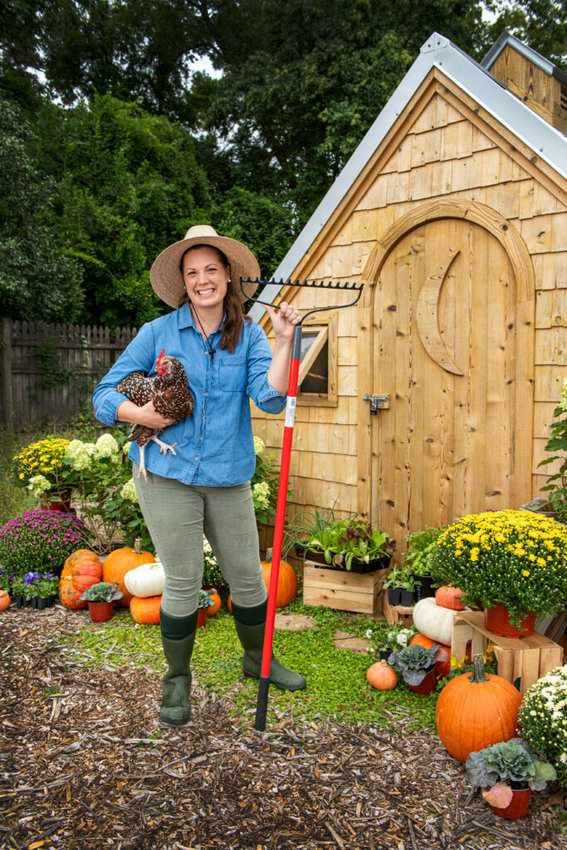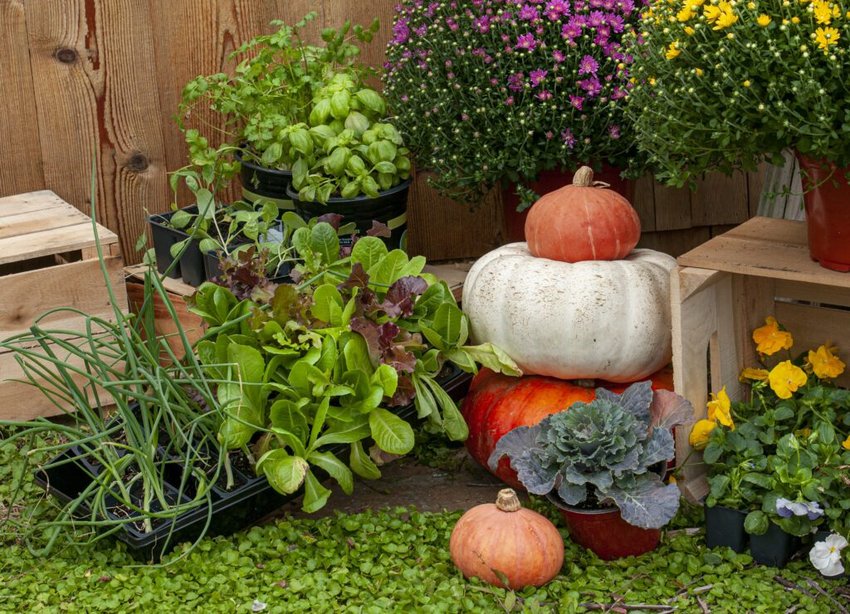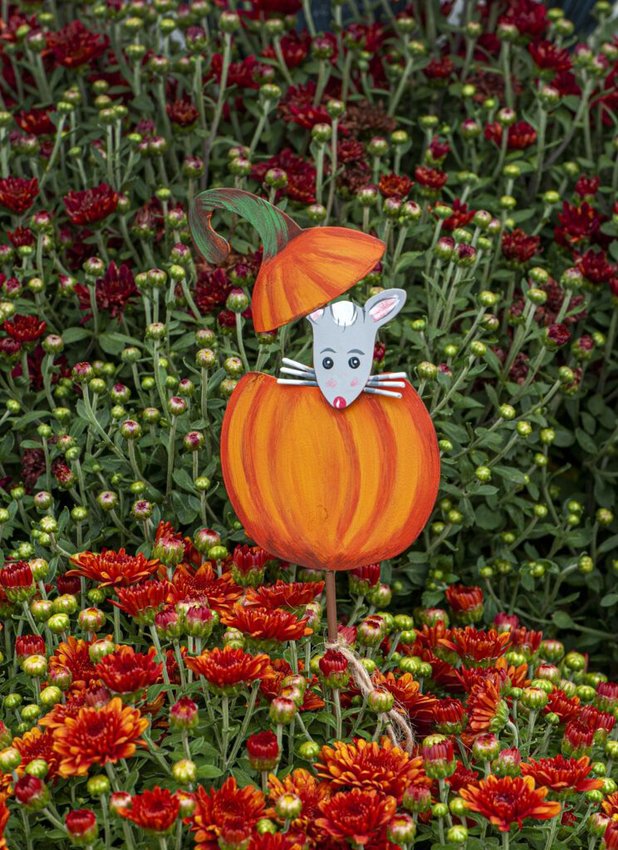Growing the food and foliage of October
By Courtney Phillips
Photography by Cindy Burnham

Each season marks a new beginning for Sally Augustine. An avid gardener since childhood, Sally and her family will enjoy a fall and winter bounty of arugula, kale, spinach, onions, beets and carrots. As a registered nurse, she values and enjoys involving her daughters, Nancy and Gwyneth, in the process of a healthful seasonal harvest.
A native Pennsylvanian, Augustine has embraced Fayetteville’s growing zone and finicky soil. In addition to testing and fertilizing for an optimal vegetable yield, she will fill planters with pansies, decorative cabbage and mums. Beneath fall foliage, she likes to hide daffodil and tulip bulbs for a spring surprise. This month, she will tuck in Limelight hydrangeas and narcissus bulbs for winter to provide a seamless transition to warm weather.
When Augustine isn’t planting at home, her hands and heart are in the dirt of Friendship Community Gardens, a Fayetteville nonprofit with a mission of planting, growing and harvesting healthy food options for local residents while creating space for racial and disability reconciliation within our community. Augustine, a member of the organization’s board, plans to fortify the soil for a fruitful spring with a groundcover crop of crimson clover. “The bees and pollinators love it,” she said, “and it has a beautiful deep red blossom to add to fall flower arrangements.”
Augustine is excited to report that FCG was recently granted funding as an official Monarch butterfly waystation. Soon, volunteers and staff will plant native milkweeds near their beehives on Ellis Street to offer a sustenance haven to some of the hundreds of millions of butterflies that migrate between the U.S., Canada and mountains of central Mexico.
If you’d like to know more about volunteering with Friendship Community Gardens, visit www.fcgfaync.org.
Meanwhile, the feeling of fall is approaching the rest of us in Fayetteville, as well. It might be 90 degrees by noon, but the fleeting deep chill of the morning soon will prompt us to officially abandon summer in a flurry of activity. The sun-bleached gourds, soggy from a month of porch baking, are being swapped for fresh, crisp pumpkins. We will teeter dangerously so that we can lasso and suspend all manner of fake spiders and skeletons from gable and dormer.
Wistfully, gardeners have plucked the last rosy tomatoes from leaf-strewn plots and will till them under, knowing that with a little luck, they will pick collards for Thanksgiving.
OCTOBER IS NOT TOO LATE
The climate of the Sandhills is surprisingly well-suited for a late fall garden, even if nothing is planted until October. “Sure, you’d rather get it in in September,” said Jeff Thomson, the famous “Blooming Idiot” of Bell’s Seed Store, but gardeners can catch up by purchasing plants rather than seeds. For some vegetables, like cabbage, broccoli and Brussels sprouts, the result of planting in October is a first crop before the end of the year and the surprising treat of a second crop in February or March.
“You double your money,” laughed Thomson. Other dependable options to plant in October are collards, spinach, turnips, mustard, rape, kale, winter squash and lettuce. Due to the decorative nature of many varieties, lettuce is gaining popularity as a fall crop. “A lot of people have started planting it, whether they’re going to eat it or not,” Thomson said.
Cold-hearty herbs like rosemary, thyme and basil will enhance winter dishes, and add flair to flower arrangements year-round. Choose a sunny spot away from cold, gusty winds.

FALL FLOWERS
Faithfully, mums roll out the welcome mat for October, playing host to the last scorching days of the year and trick-or-treaters alike. Available in every autumnal hue, they put on a show for four to six weeks, and how do we show our appreciation? We heave them into the trash after Thanksgiving. Thomson has a better plan: “When they die back in the fall, cut them back to an inch or two high, and plant them in your yard.” A perennial plant, they will come back every year. To maximize blooms in the fall, cut back the leafy green foliage in July. “When you’re celebrating on the Fourth of July, you go back out to those mums and cut them back about six inches tall. They’ll grow right back out again, and in the fall, you’ll get a heavy bloom.” Pansies and violas are colorful, classic annuals that will not only survive, but thrive in the winter months of Zone 8A. Thomson’s directions for successful pansy-keeping are simple: Wait for a true break in the hot weather before planting, lest they become leggy and temperamental.
Then, next May, at peak bloom, start thinking about their replacement. “After five or six days of 85-degree weather, they’re just going to melt away and look terrible.” Decorative mustard, flowering cabbage and flowering kale offer pops of color in both leaf and stem, lending interest and texture. “The word ‘flowering’ is deceptive,” Thomson said, as he explained that flowers should be removed to promote continued growth of colorful leaves.
DON’T GROW WEEDS
For the gardener who prefers to hibernate in colder months, applying groundcover is both a functional and aesthetically pleasing step to winterize a garden plot. Groundcover discourages weed growth and provides natural organic matter to enrich soil. Thomson noted ryegrass, a nitrogen powerhouse, and white clover as regional favorites.
If a green lawn is the goal for winter, October is a good time for an all-over application of ryegrass, but exercise restraint. While winter grasses die back in summer, their roots will continue to sneakily leach nutrients and water needed by permanent grass.
To ward off pesky weeds like crabgrass and poa annua (say it like this: poe-uh-anna), apply a pre-emergent herbicide. Bell’s sells a lot of Balan (sounds like: bay-lan), which is a granular pre-emergent that will not kill what is currently growing, but will prevent germination of weeds on warm winter days. Mid-September to mid-October should be the first application, with a second in February to mid-March.

FERTILIZING
If you don’t already fertilize your lawn for winter, October is the critical time to do that. “Fertilizer needs to go down before grass goes dormant, so it takes up the nutrients,” advised Thomson. Potash 0-0-20 will feed the root system to prevent winter damage and help grass emerge healthier and stronger in the spring.
Conversely, feeding a productive garden should be done in small doses throughout the colder months. “Miracle Grow is great, but it needs to be done every two weeks. Plants process it very quickly. Granular fertilizer needs to be done every month,” Thomson said.
One garden spreader can be used for each step of winterizing. Due to the size of the pellets, Thomson detailed, “Balan will need the lightest setting, potash the middle setting and ryegrass the wide-open setting.”
Jeff Thomson, the famous “Blooming Idiot” of Bell’s Seed Store, advises to put fertilizer down before your lawn goes dormant.
TESTING, TESTING
The soil of the Sandhills region is, well, sandy and acidic, so if a fall garden is in the ground, it probably needs lime. A soil test from the Cumberland County Cooperative Extension Service will pinpoint deficiencies and explain corrective action. “A very scientific process,” Thomson said. The test not only determines pH, but takes into consideration consistency, mineral content and density in their detailed recommendations.
While the test might take a couple weeks to complete, soil can be amended after planting is complete, so no need to put off big plans. From April to Nov. 30, the service is free, but expect to pay $4 from December to March 31. Visit the Extension office to collect a sample box and chat with their knowledgeable staff.
As we uncertainly enter a season traditionally filled with boundless camaraderie, there will never be a better time to get a little dirt under our nails and sun on our faces. Whether novice or expert, let’s get growing.